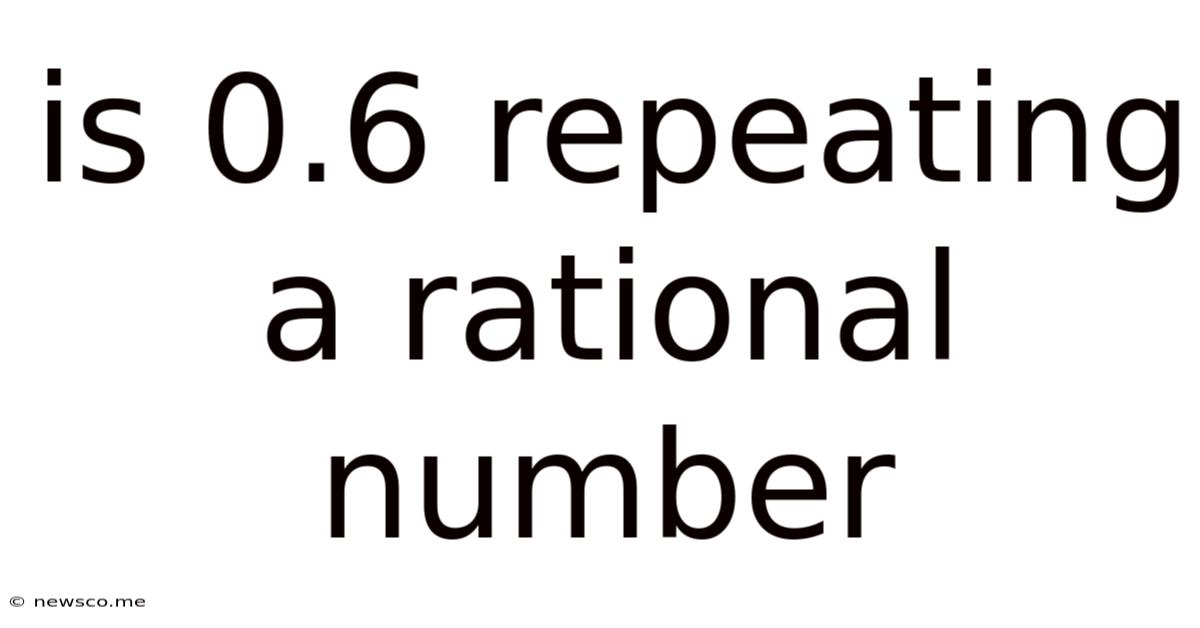Is 0.6 Repeating A Rational Number
News Co
May 07, 2025 · 5 min read

Table of Contents
Is 0.6 Repeating a Rational Number? A Deep Dive into Rational and Irrational Numbers
The question of whether 0.6 repeating (0.6666... or 0.<u>6</u>) is a rational number is a fundamental concept in mathematics. Understanding this requires a clear grasp of what constitutes a rational number and how to represent repeating decimals as fractions. This article will delve into the intricacies of rational and irrational numbers, providing a comprehensive explanation and demonstrating how to prove 0.6 repeating is indeed rational.
Understanding Rational Numbers
A rational number is any number that can be expressed as a fraction p/q, where p and q are integers, and q is not zero. This seemingly simple definition encompasses a vast range of numbers, including:
- Integers: Whole numbers, both positive and negative (e.g., -3, 0, 5). These can be represented as fractions with a denominator of 1 (e.g., -3/1, 0/1, 5/1).
- Terminating Decimals: Decimals that end after a finite number of digits (e.g., 0.25, 3.75, -1.5). These can be easily converted into fractions.
- Repeating Decimals: Decimals where a sequence of digits repeats infinitely (e.g., 0.<u>3</u>, 0.<u>142857</u>, 0.666...). While seemingly more complex, these can also be expressed as fractions.
Irrational Numbers: The Counterpart
Irrational numbers are numbers that cannot be expressed as a fraction p/q, where p and q are integers, and q is not zero. These numbers have decimal representations that neither terminate nor repeat. Famous examples include:
- π (pi): The ratio of a circle's circumference to its diameter, approximately 3.14159...
- e (Euler's number): The base of the natural logarithm, approximately 2.71828...
- √2 (the square root of 2): Approximately 1.41421...
Proving 0.6 Repeating is Rational: The Method
To prove that 0.6 repeating is a rational number, we need to demonstrate that it can be expressed as a fraction. We can achieve this using algebraic manipulation.
Let x = 0.<u>6</u>
This means:
x = 0.66666...
Now, multiply both sides of the equation by 10:
10x = 6.66666...
Next, subtract the first equation (x = 0.66666...) from the second equation (10x = 6.66666...):
10x - x = 6.66666... - 0.66666...
This simplifies to:
9x = 6
Now, solve for x by dividing both sides by 9:
x = 6/9
Simplifying the fraction by dividing both the numerator and denominator by their greatest common divisor (3), we get:
x = 2/3
Therefore, 0.<u>6</u> is equal to the fraction 2/3, fulfilling the definition of a rational number.
General Method for Converting Repeating Decimals to Fractions
The method used above can be generalized to convert any repeating decimal to a fraction. Here's a step-by-step guide:
- Assign a variable: Let x equal the repeating decimal.
- Multiply: Multiply both sides of the equation by 10<sup>n</sup>, where n is the number of digits in the repeating block. (In our example, n=1 because only "6" repeats).
- Subtract: Subtract the original equation from the new equation. This will eliminate the repeating decimal part.
- Solve: Solve the resulting equation for x to express the repeating decimal as a fraction.
- Simplify: Simplify the fraction to its lowest terms.
Examples of Converting Repeating Decimals to Fractions
Let's apply this general method to a couple more examples:
Example 1: 0.<u>3</u>
- x = 0.<u>3</u>
- 10x = 3.<u>3</u>
- 10x - x = 3.<u>3</u> - 0.<u>3</u> => 9x = 3
- x = 3/9 = 1/3
Example 2: 0.<u>142857</u>
- x = 0.<u>142857</u>
- 10<sup>6</sup>x = 142857.<u>142857</u>
- 10<sup>6</sup>x - x = 142857.<u>142857</u> - 0.<u>142857</u> => 999999x = 142857
- x = 142857/999999 = 1/7
The Significance of Rational Numbers
The classification of numbers as rational or irrational is crucial in various mathematical fields. Understanding the distinction helps us:
- Perform Calculations: Rational numbers allow for precise calculations and manipulations, unlike irrational numbers which often require approximations.
- Solve Equations: Knowing whether a number is rational or irrational can guide our approach to solving equations and finding solutions.
- Understand Number Systems: The rational numbers form a dense subset of the real numbers, meaning between any two rational numbers, there exists another rational number. This property has significant implications in calculus and analysis.
Beyond the Basics: Deeper Explorations
The concept of rational and irrational numbers opens doors to more advanced mathematical concepts. Further exploration could include:
- Continued Fractions: An alternative way to represent rational and irrational numbers.
- Transcendental Numbers: A subset of irrational numbers that are not the root of any non-zero polynomial with rational coefficients.
- Set Theory and Cardinality: Investigating the size and properties of the set of rational numbers compared to the set of irrational numbers.
Conclusion: Rationality Confirmed
Through algebraic manipulation and the demonstration of its fractional representation (2/3), we have conclusively shown that 0.6 repeating is a rational number. This understanding forms a fundamental building block for further explorations in mathematics and highlights the importance of understanding different number systems and their properties. The ability to convert repeating decimals to fractions is a valuable skill with applications across various mathematical disciplines. Remember that the ability to express a number as a fraction p/q, where p and q are integers, and q is not equal to zero, is the definitive characteristic of a rational number.
Latest Posts
Related Post
Thank you for visiting our website which covers about Is 0.6 Repeating A Rational Number . We hope the information provided has been useful to you. Feel free to contact us if you have any questions or need further assistance. See you next time and don't miss to bookmark.